Stand-Alone Lessons and Activities
Jewish Values: Chinuch – Education and Study
Chinuch () – Education and Study:
Engage students in one or more of the following activities to explore the Jewish value of Chinuch– Education and Study:
- Have students complete Worksheet K, or explore the photograph, questions, and texts on the worksheet together through class discussion.
- Have students view the photograph Synagogue Attic, Scribe, or Summer Camp and respond to the photo using one of the following creative response exercises:
- Ask students to write about the scene, describing what they think happened just before the picture was taken and what they think will happen next.
- Have students write a monologue from the point of view of one of the people or objects in the photograph.
- Have students paste a photocopy of the image in the center of a piece of white paper and ask them to draw what they think is happening outside the frame of the photo.
- Have students assume the physical positions of the figures in the photograph and then ask them to act out the scene.
- After listing the students’ subjective observations, ask them to create poems about the photo, using the language of their observations. Have students share their work and discuss the relationship between visual art and poetry.
- Make a photocopy of the image along with thought bubbles above the heads of some of the figures. Have students fill in the bubbles with what they think the subjects of the photograph are thinking.
- Have students create a soundtrack for the image, or a “musical collage,” by editing music clips into a medley that expresses something about the photo.
- Have students compare the photographs Upsherin, Older Sister, and The Shape of Sound. Discuss:
- What do these photographs have in common?
- How are they different?
- What do they suggest about the role of education within the world Jewish community?
- Why do Jews consider the Hebrew language so important?
- Have students take photographs in school, at home, or in the community that reflect the value of chinuch, or have them create and photograph a series of “tableaux”—staged scenes—that depict the value. Share and discuss.
- What was challenging about this assignment?
- How does your photograph reflect chinuch? Is it possible to capture this value fully in a photograph?
- What is similar or different among the various photographs students took?
- What title would you give your photograph? Why?
- Discuss the way we, as Jews, treat sacred books. Why do we give so much honor to inanimate pages? You may want to start a genizah project, wherein students collect discarded texts and either repair them or bury them in the traditional manner.
IMAGES
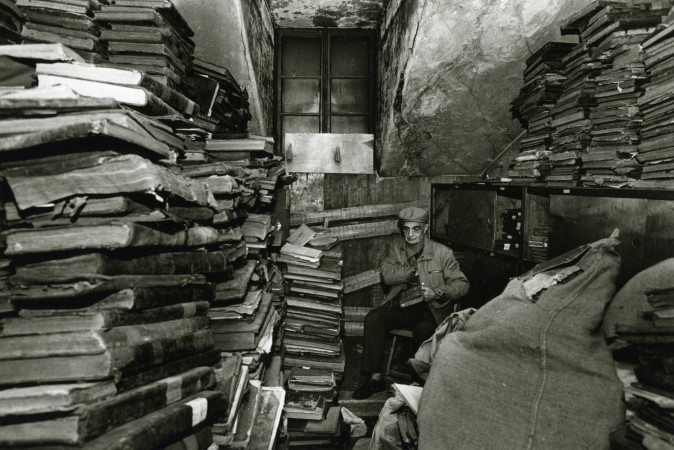
Synagogue Attic, Riga, Latvia, 1991
Before World War II, there were many synagogues in Riga, the capital of Latvia. In fact, until the 20th century, Eastern Europe was a center for Jewish life and learning. But today, only one synagogue still stands in Riga. And just a handful of elderly Jews, like the man in this picture, still attend services. During the communist period, young people were intimidated by the police to keep them from going to synagogue. But if you climb up to the synagogue’s attic, you will discover stacks and stacks of ancient Jewish books. These books remind us that there once was a large and active Jewish community there.
According to Jewish law, sacred books can’t be thrown away. They must either be set aside in a special storage area called a genizah or buried in the ground.
The photographer, Zion Ozeri, explains how he came to take this picture: “When we came, there were only a few elderly men in the synagogue. This one [in the picture] is the gabbai, actually. And I asked the translator to ask him—I found it strange that in a big synagogue there were only a few prayerbooks. So I asked him to ask about that. And the man kind of got a little insulted, because he thought I was questioning their Jewishness. So he said to the translator, ‘Does he want to see books? I’ll show him books.’ So he took us to the attic. It turns out they had put all of their books in the attic, because the communists didn’t want to see that richness of Jewish life. Because when you see so many books, what does that mean? It means that this culture and tradition is very rich. So they put everything in the attic. He was actually reaching for his glasses to show me a book, to show me how ancient these books were. At that moment I saw this image and I took a photograph of it.”
Sample Texts:
, , , , ; , .
Ben Bag-Bag taught:
Study it [Torah] and review it; you will find everything in it.
Scrutinize it, grow old and gray in it, do not depart from it. There is no better portion in life than this.
– Pirkei Avot 5:24
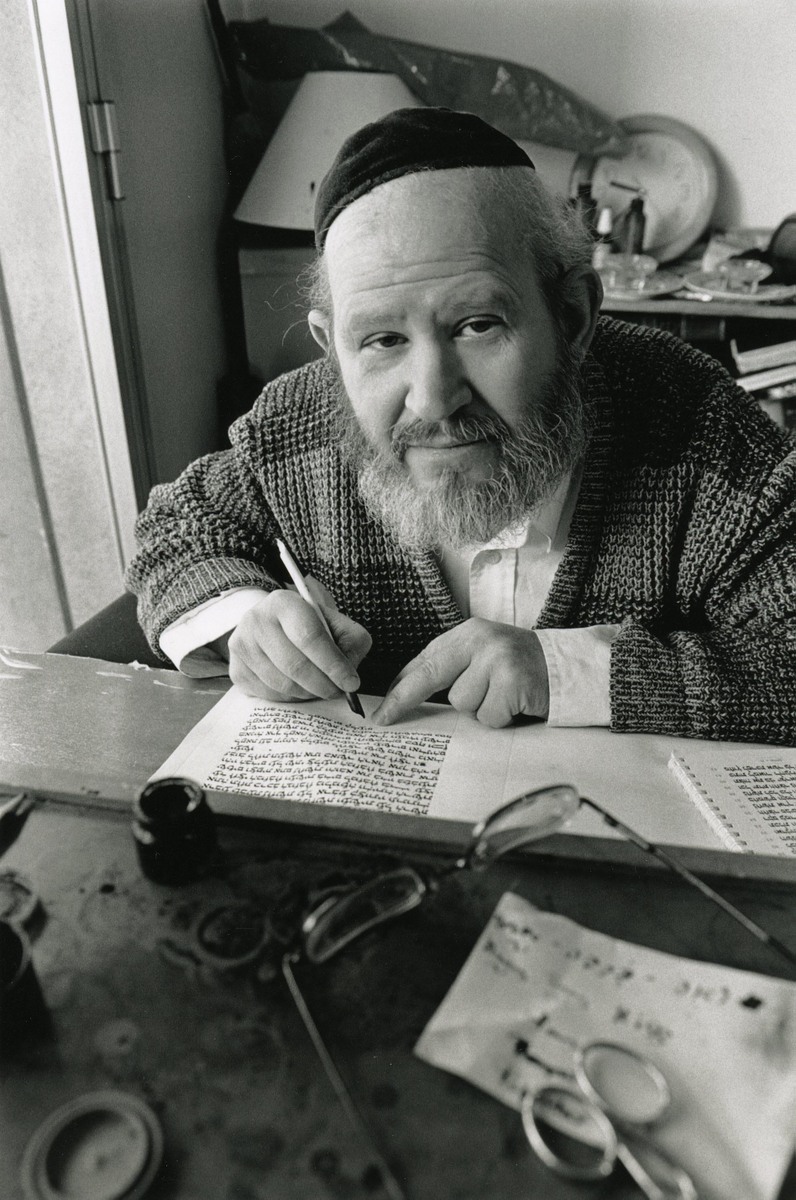
Scribe, Marseille, France, 2006
This sofer (scribe) in Marseille, France, is writing a Torah scroll. A kosher Torah scroll must be written by hand by a trained scribe, using quill pens, special ink, and parchment made from animal skin. The scribe cannot simply write the Torah from memory; he must carefully copy every word from an existing Torah. It can take as long as one year to write a single Torah scroll.
Marseille is the second largest city in France, and it’s home to the third largest Jewish community on the European continent. Jews lived there as early as the 6th century. During the Middle Ages, Jewish merchants settled in the lower part of the city near the port, trading with Jews and Christians from around the Mediterranean region. The Jews were granted the status of citizens and in the 14th century even given special consideration—for example, they were exempted from having to sweep in front of their houses on Saturday and from having to carry a lantern after curfew on Jewish holidays. In the 15th – 17th centuries, however, the Jews of Marseille faced a number of persecutions. The Jewish population dropped considerably by the 18th century but began to grow again in the 19th century. During the Holocaust, the city was in the unoccupied part of France. Jews from other parts of Europe and North Africa took refuge there and helped rebuild the community after the war. Since the Holocaust, the Jewish community of Marseille has continued to grow, with the arrival of many Jewish immigrants from North Africa.
Sample Texts:
Have a beautiful scroll of the Law prepared, copied by an able scribe with fine ink and fine calamus; and wrapped in beautiful silk.
– Babylonian Talmud, Shabbat 133b
The Torah and all its commandments in their minutest details, as expressed in thought and deed, for a great and mighty Divine poem, a poem of confident trust and love. Every commandment and law has a unique musical quality that the congregation of Israel perceives and appreciates. It evokes the blossoms of reverent joy and song within us. It is for us to remove the warts from the ears of our sons, “the thorns and thistles that surround the noble flower,” so that the waves of song will echo in their hearts as well, uplifting their souls with the same natural exaltation that is common to all in whom the spirit of Judaism is properly developed.
– Abraham Isaac Kook, quoted in Banner of Jerusalem by Jacob B. Agus
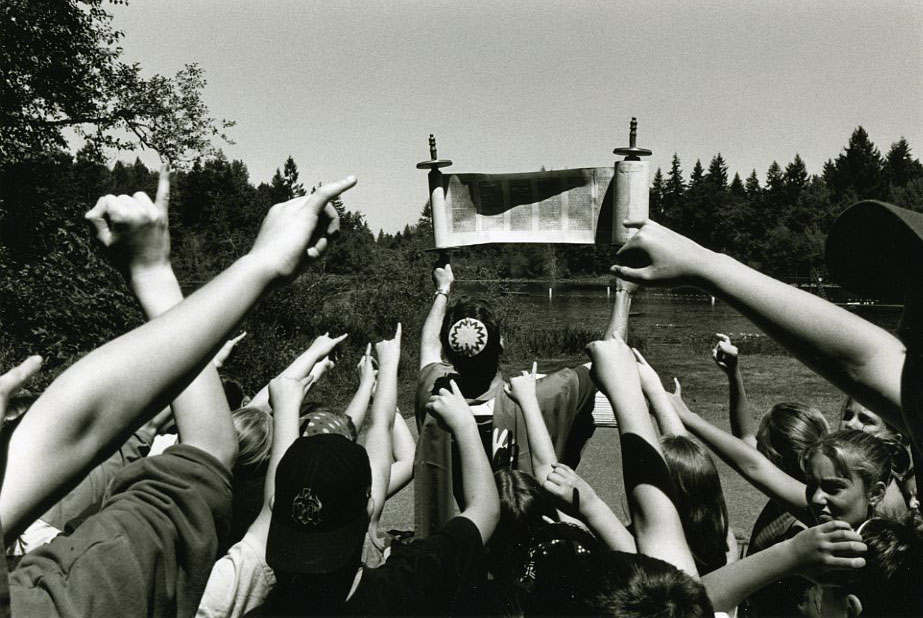
Summer Camp, Tumwater, Washington, 2002
It’s time for morning services at Camp Solomon Schechter, in Tumwater, Washington. As the Torah is raised, the kids point with their fingers, symbolically kissing the Torah and lending their support to the Magbiah, who lifts up the scroll.
Founded fifty years ago, Camp Solomon Schechter in Tumwater, Washington, “provides Jewish youth, families, and adults from the U.S. and Canada with a Jewish, active, and fun camping and retreat experience year-round in the Pacific Northwest.” In addition to hosting a summer camp for kids of all ages, the site is used by Jewish organizations throughout the year for retreats, meetings, and other community events.
Sample Texts:
,
, ;
, .
Rabbi Yose taught:
Whoever honors Torah will himself be honored by others;
Whoever dishonors Torah will himself be dishonored by others.
– Pirkei Avot 4:8
, ‘, , .
A person should see to it that the body is kept healthy and strong in order that they may be upright to know G-d. For it is impossible to understand and comprehend wisdom when one is hungry and ailing or if one’s limbs ache.
– Maimonides, Mishneh Torah, Hilchot Deot, 3:3
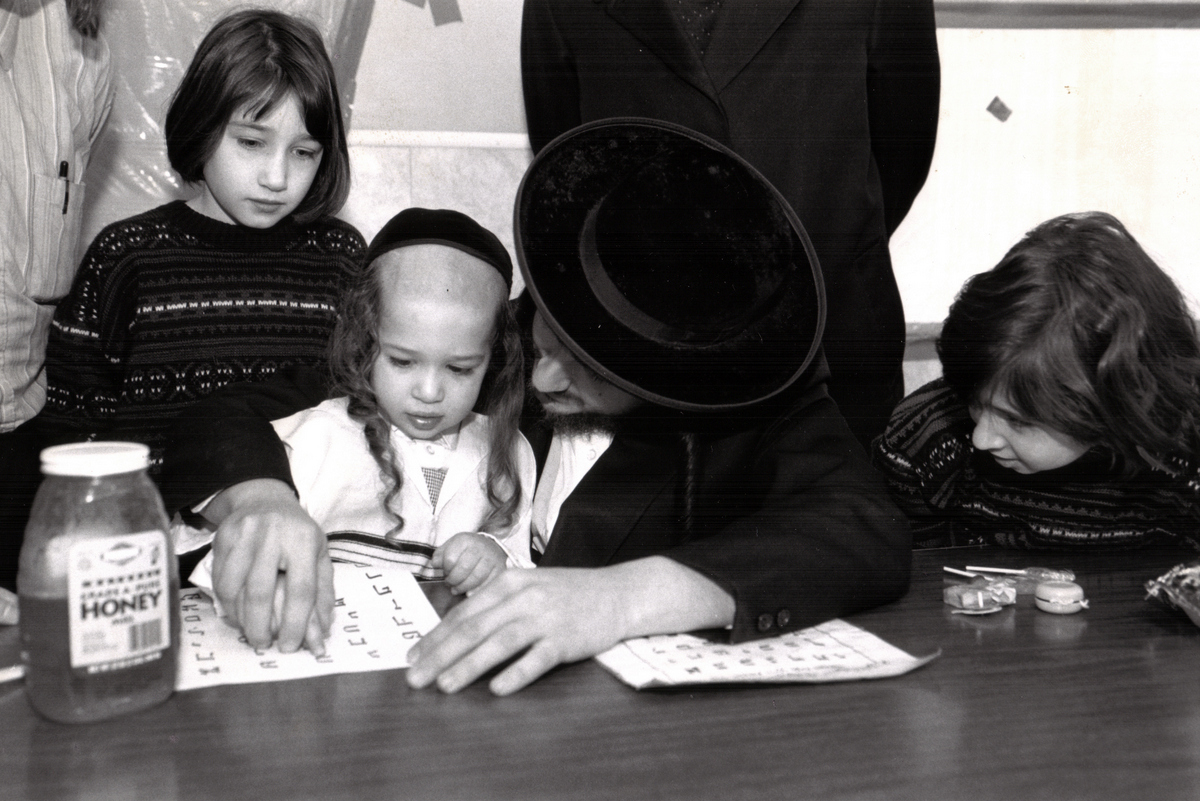
Upsherin, Williamsburg, Brooklyn, New York, 1995
What do you see in this photograph? A young boy sits on a rabbi’s lap, and together they point to Hebrew letters while a jar of honey sits beside them on the table. It is a custom in some communities that when a boy reaches three years of age, he gets his hair cut for the first time (everything except the peot, or corners) and learns his first Hebrew letters. But what is the honey for? They use the honey to show the child that studying Torah is sweet. This is an important event in the life of this boy: His sisters and other family members look on as he starts down the path of Talmud Torah—Jewish learning.
Sample Texts:
There are three names by which a person is called:
One by which her father and mother call her,
And one by which others call her,
And that which she earns for herself.
The best one of these is the one that she earns for herself.
– Adapted from the Midrash Tanhuma
, , , , . : , , .
At Sinai Moses received the Torah and handed it over to Joshua who handed it over to the elders who handed it over to the prophets who in turn handed it over to the men of the Great Assembly. The latter said three things: Be deliberate in judgment, raise up many disciples, and make a fence around the Torah.
– Pirkei Avot 1:1
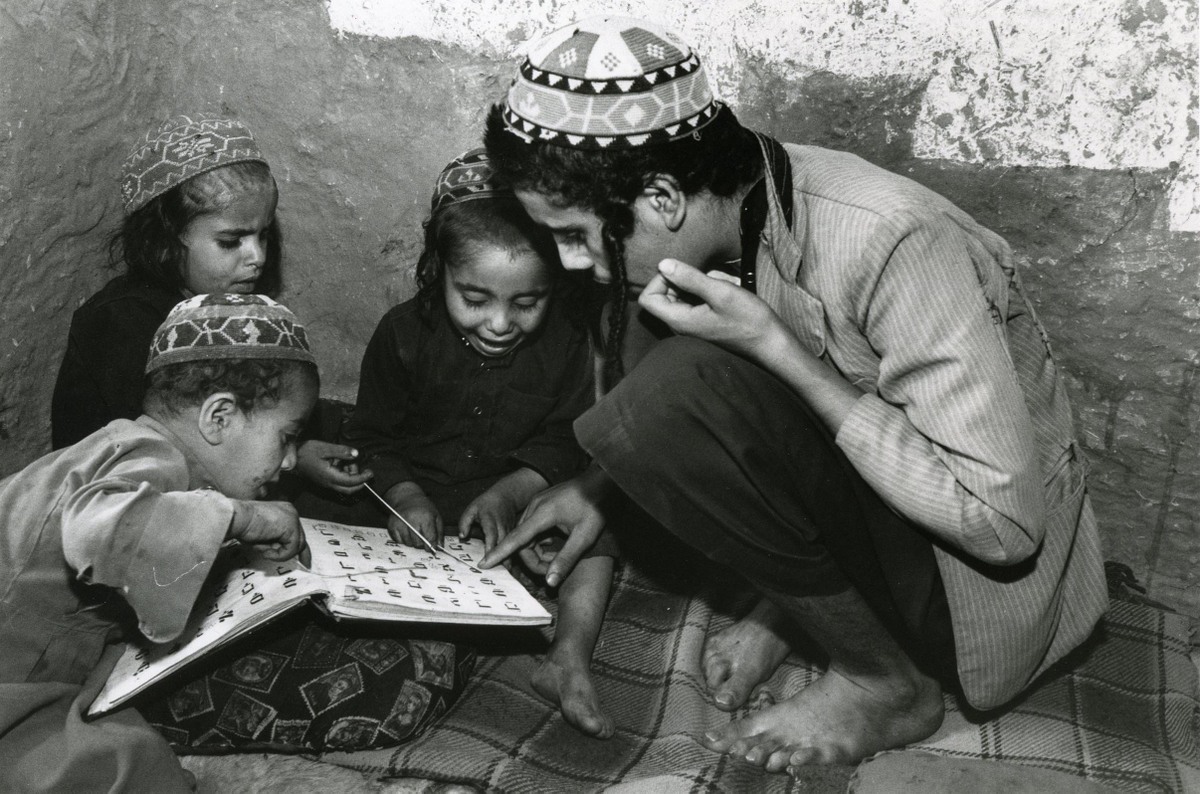
The Shape of Sound, Yemen, 1991
Whether you’re in a cave in Yemen or a yeshiva in Brooklyn, the letters of the Hebrew alphabet and the words of the Torah remain the same. It is these universal Jewish traditions that keep communities connected across time and space.
Why do you think the photographer calls this picture The Shape of Sound?
Sample Texts:
, – , ”- “ ( ,).
Ben Zoma said: Who is wise? One who learns from all people, as it is written (Psalm 119:99) “I have gained understanding from all my teachers.”
– Pirkei Avot 4:1
, – , ”, -“ ( ,). , ” - “ ( ,). , ” “ ( ,). , ” , -; , “ ( ,). , ”- -, ” ( ,).
Rabbi Chalafta of Kefar Chanania used to say: If ten people sit together and occupy themselves with the Torah, the Divine Presence rests among them as it is written (Psalm 82:1) “God has taken his place in the divine assembly.” And from where do we learn that this applies even to five? Because it is written (Amos 9:6) “He has established his vault upon the earth.” And how do we learn that this applies even to three? Because it is written (Psalm 82:1) “He judges in the midst of the judges.” And from where can it be shown that the same applies even to two? Because it is written (Malachi 3:16) “Then those who revered the Lord spoke with one another. The Lord took note and listened.” And from where even of one? Because it is written (Exodus 20:24) “In every place where I cause my name to be remembered I will come to you and bless you.”
– Pirkei Avot 3:7
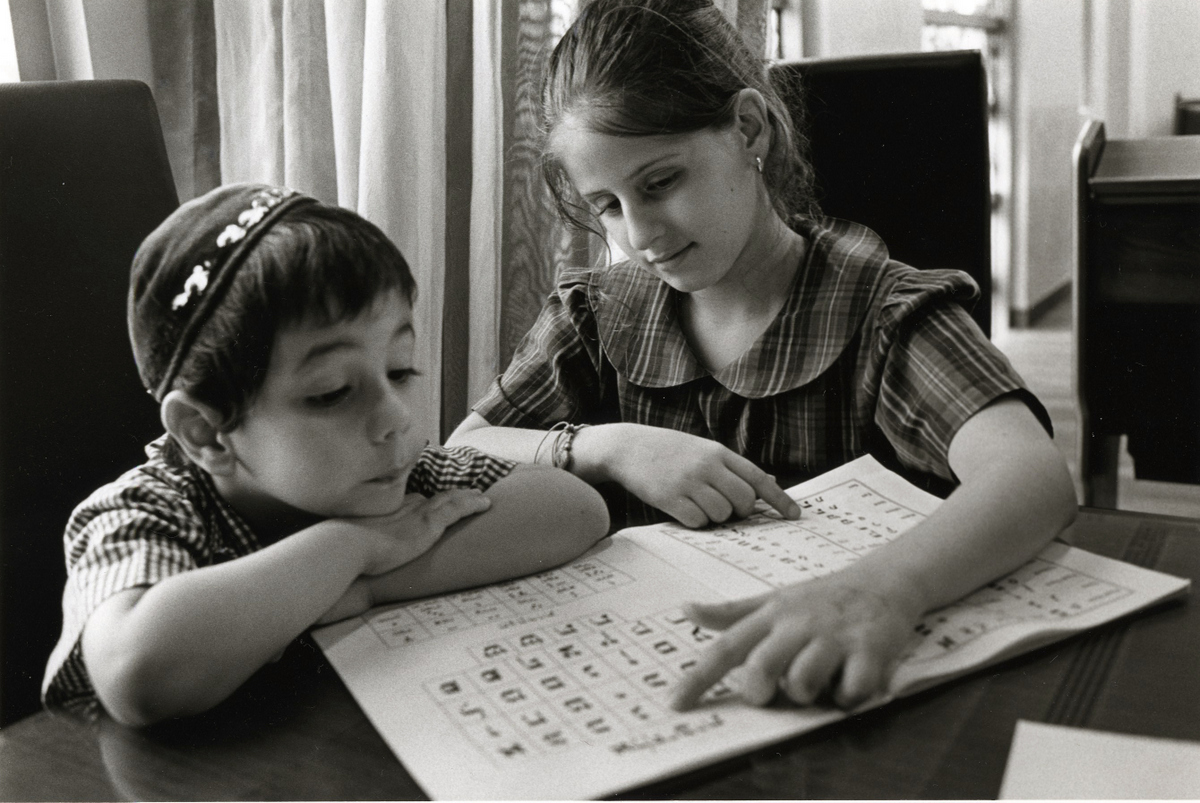
Older Sister, Hong Kong, 2008
Hong Kong may not be the first place most people think of when they think of Jewish communities, but Jews have lived there for at least 150 years. Persian Jewish merchants arrived in Hong Kong in 1842, after China ceded the territory to Great Britain. Hong Kong’s first synagogue opened in 1900, but the community remained small—by the 1950s, the Jewish community numbered just 250, roughly half Sephardic and half Ashkenazi. With the city’s development as a trade and finance center in the past several decades, however, Hong Kong’s Jewish community has grown substantially. The Jewish population of Hong Kong is now between three and four thousand people, about two-thirds of whom come from the U.S., Israel, or England.
Hong Kong now has four synagogues, a Jewish community center, a kosher restaurant, and two Jewish schools. Because Hong Kong is a commercial hub, its Jewish institutions must serve not only the full-time residents of the community but also the many businesspeople who pass through in the course of their work.
The photograph above was taken in one of Hong Kong’s synagogues. Compare this image with the photographs The Shape of Sound and Upsherin, also taken by Ozeri. The common threads of Hebrew language and learning can be easily traced around the globe.
Sample Texts:
: , .
O how I love Your teaching! It is my study all day long.
– Psalms (Tehilim) 119:97
“One who tends a fig tree will enjoy its fruit,
And one who cares for a master will be honored.”
– Proverbs (Mishlei) 27:18
Why is Torah compared to a fig tree?
Because most trees—olive, grape, date—have their fruit picked at one time. But the fig’s fruit is picked gradually.
And so it is with the Torah: You learn a little today and more tomorrow; you cannot learn it all in just one or two years…
– Midrash Numbers Rabbah 12:9
Whenever children are learning, there dwells the divine presence.
– Yiddish saying

